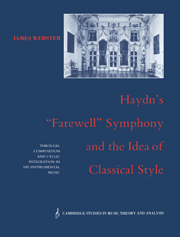 Haydn's 'Farewell' Symphony and the Idea of Classical Style
Haydn's 'Farewell' Symphony and the Idea of Classical Style Book contents
- Frontmatter
- Contents
- Foreword by Ian Bent
- Preface
- Author's note
- List of abbreviations
- Introduction
- PART I THE FAREWELL SYMPHONY
- 1 The construction of the whole
- 2 Instability
- 3 Resolution
- 4 The program
- PART II CYCLIC ORGANIZATION IN HAYDN'S INSTRUMENTAL MUSIC
- Historiographical conclusion: Haydn's maturity and “Classical style”
- Bibliography
- Index
1 - The construction of the whole
Published online by Cambridge University Press: 28 January 2010
- Frontmatter
- Contents
- Foreword by Ian Bent
- Preface
- Author's note
- List of abbreviations
- Introduction
- PART I THE FAREWELL SYMPHONY
- 1 The construction of the whole
- 2 Instability
- 3 Resolution
- 4 The program
- PART II CYCLIC ORGANIZATION IN HAYDN'S INSTRUMENTAL MUSIC
- Historiographical conclusion: Haydn's maturity and “Classical style”
- Bibliography
- Index
Summary
A THROUGH-COMPOSED SYMPHONY
The Farewell Symphony is arguably Haydn's most extraordinary composition. It is his only symphony in five real movements – Allegro assai, Adagio, minuet and trio, Presto, and the “farewell” movement itself. The last two movements constitute a throughcomposed double finale, unique in Haydn's symphonies; the concluding movement is not only an adagio, but ends in a different key from that in which it begins. (The term “double finale” is explicated below; Haydn's other symphonies which alter the usual cyclic patterns are described in Chapters 6–8.) The symphony also has an unusual and complex tonal scheme, involving three different structural tonics, F-sharp minor, A major, and F-sharp major; the double finale alone incorporates all three. A contemporary listener could have inferred the existence of an extramusical basis for the work directly from these disruptions of normal generic expectations – as easily as for Haydn's Symphony No. 60, “II distratto,” in six eccentric movements; or Beethoven's “Pastoral” Symphony in five, the last three run-on.
The Presto and the farewell movement constitute a run-on movement pair; that is, two contiguous movements, each of which articulates a complete formal design, except that the first breaks off towards the end or closes on the dominant, the second following attacca. The Presto is in sonata form (except for breaking off at the last moment); the farewell movement, despite beginning and ending in different keys, executes a complete form as well. (Neither movement is a mere introduction, coda, or “frame”; if either were, we would speak instead of a compound [single] movement.)
- Type
- Chapter
- Information
- Haydn's 'Farewell' Symphony and the Idea of Classical StyleThrough-Composition and Cyclic Integration in his Instrumental Music, pp. 13 - 29Publisher: Cambridge University PressPrint publication year: 1991
